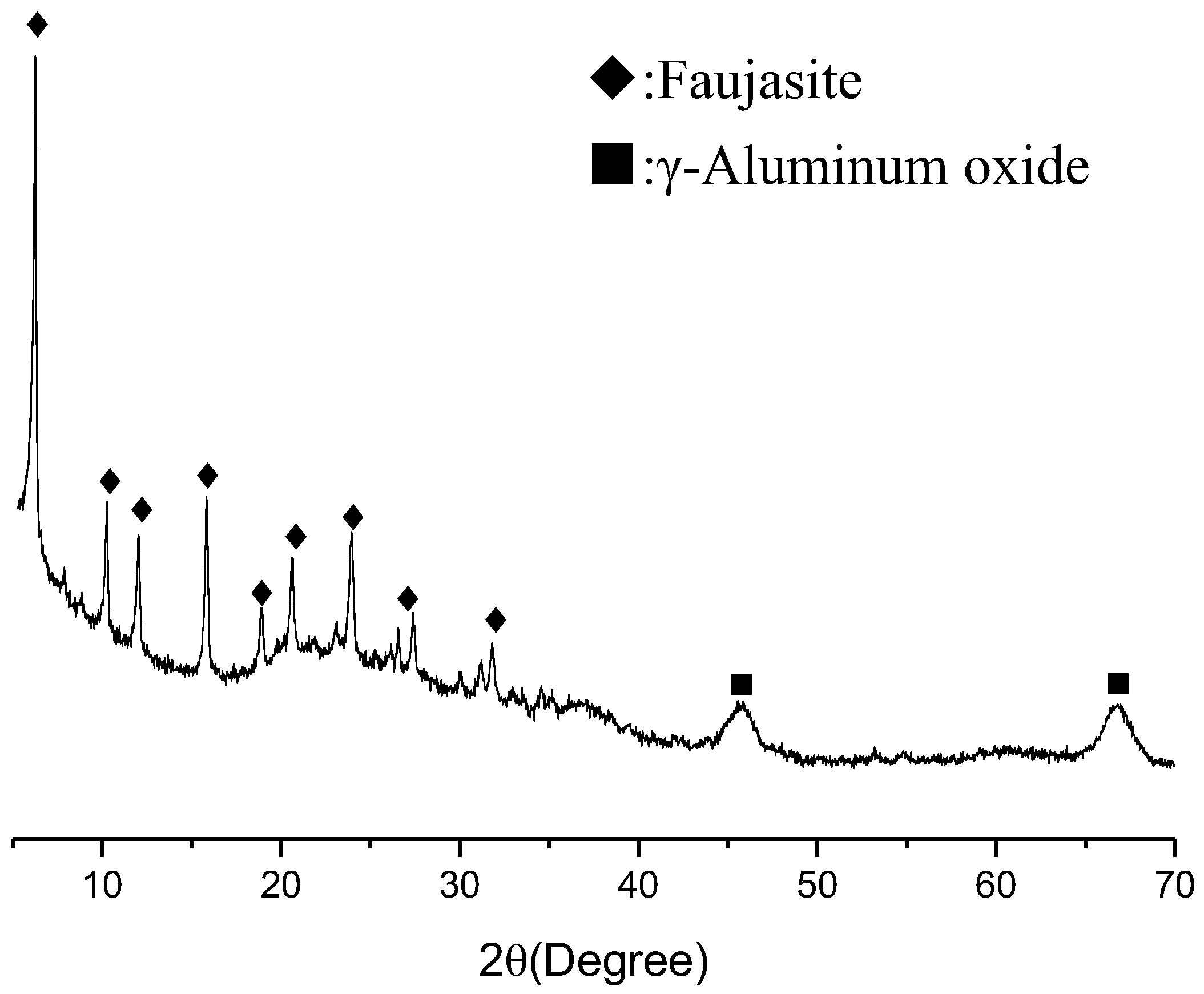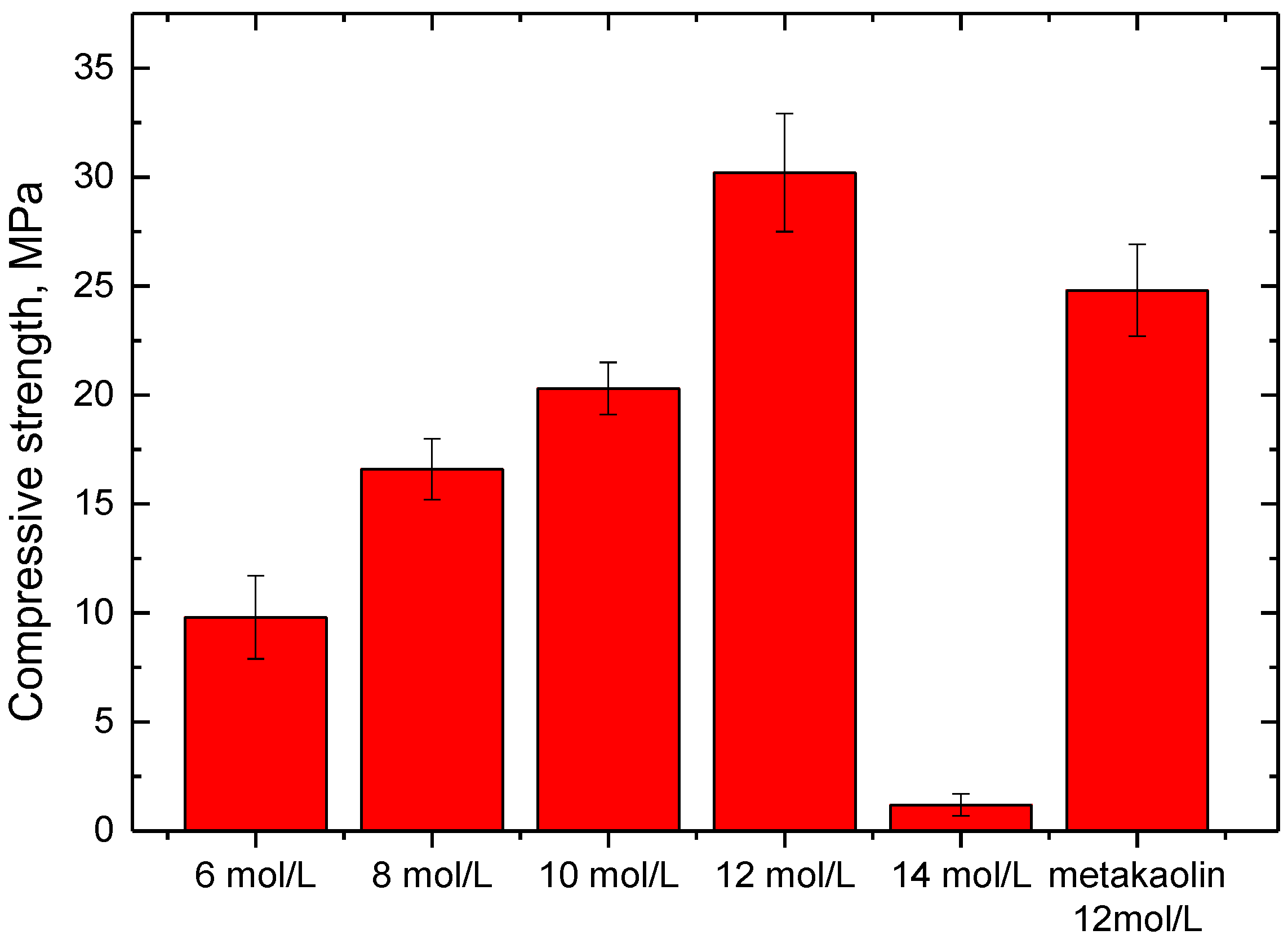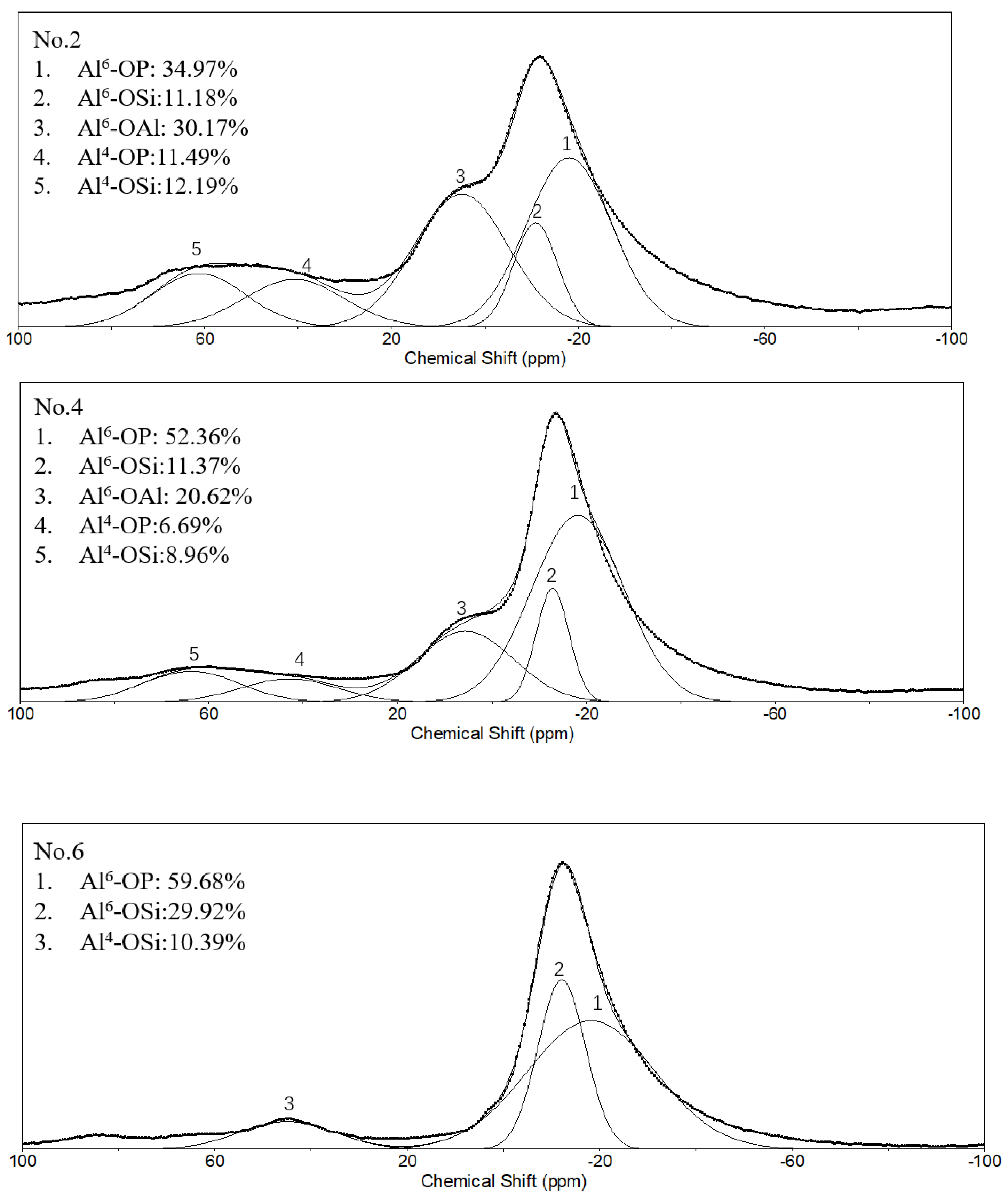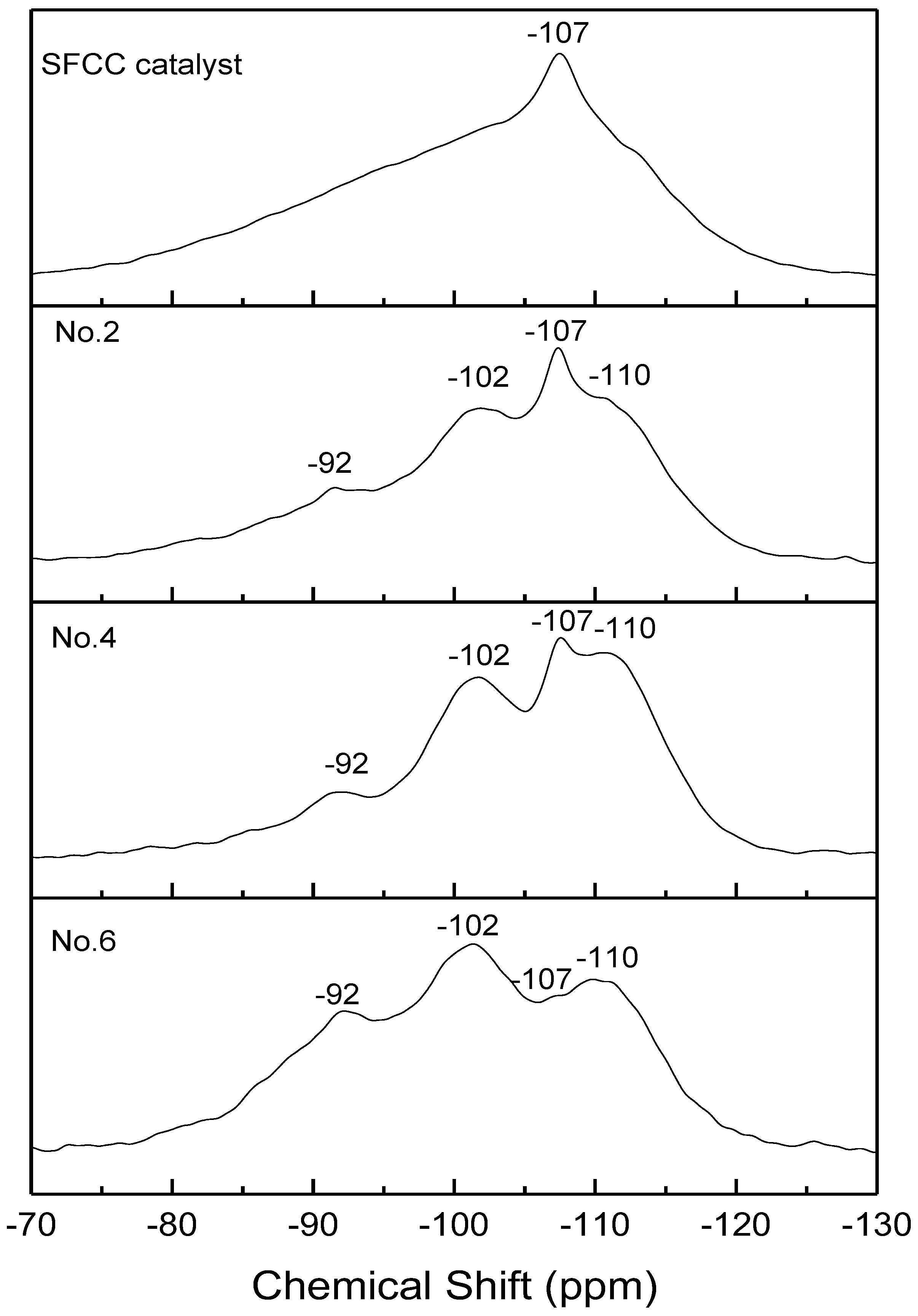Structure and Properties of Phosphate-Based Geopolymer Synthesized with the Spent Fluid Catalytic-Cracking (SFCC) Catalyst
Abstract
:1. Introduction
2. Experimental Setup
2.1. Materials
2.2. Synthesis of Geopolymer
2.3. Characterization
3. Results and Discussion
4. Conclusions
Author Contributions
Funding
Institutional Review Board Statement
Informed Consent Statement
Data Availability Statement
Acknowledgments
Conflicts of Interest
References
- Davidovits, J. Geopolymer chemistry and sustainable development. The poly (sialate) terminology: A very useful and simple model for the promotion and understanding of green-chemistry. In Proceedings of the World Congress Geopolymer. Saint Quentin, France, 29 June 2005; pp. 9–15. [Google Scholar]
- Wan, Q.; Rao, F.; Song, S.; García, R.E.; Estrella, R.M.; Patino, C.L.; Zhang, Y. Geopolymerization reaction, microstructure and simulation of metakaolin-based geopolymers at extended Si/Al ratios. Cem. Concr. Compos. 2017, 79, 45–52. [Google Scholar] [CrossRef]
- Tchakouté, H.K.; Rüscher, C.H. Mechanical and microstructural properties of metakaolin-based geopolymer cements from sodium waterglass and phosphoric acid solution as hardeners: A comparative study. Appl. Clay Sci. 2017, 140, 81–87. [Google Scholar] [CrossRef]
- Tome, S.; Bewa, C.N.; Nana, A.; Nemaleu, J.G.D.; Etoh, M.A.; Tchakouté, H.K.; Kumar, S.; Etame, J. Structural and Physico-mechanical Investigations of Mine Tailing-Calcined Kaolinite Based Phosphate Geopolymer Binder. Silicon 2021. [Google Scholar] [CrossRef]
- Hanjitsuwan, S.; Chindaprasirt, P.; Pimraksa, K. Electrical conductivity and dielectric property of fly ash geopolymer pastes. Int. J. Miner. Metall. Mater. 2011, 18, 94–99. [Google Scholar] [CrossRef]
- Zhang, B.; Guo, H.; Yuan, P.; Deng, L.; Zhong, X.; Li, Y.; Wang, Q.; Liu, D. Novel acid-based geopolymer synthesized from na-nosized tubular halloysite: The role of precalcination temperature and phosphoric acid concentration. Cem. Concr. Compos. 2020, 110, 103601. [Google Scholar] [CrossRef]
- Wang, Y.-S.; Dai, J.-G.; Ding, Z.; Xu, W.-T. Phosphate-based geopolymer: Formation mechanism and thermal stability. Mater. Lett. 2017, 190, 209–212. [Google Scholar] [CrossRef]
- Guo, C.-m.; Wang, K.-t.; Liu, M.-y.; Li, X.-h.; Cui, X.-m. Preparation and characterization of acid-based geopolymer using me-takaolin and disused polishing liquid. Ceram. Int. 2016, 42, 9287–9291. [Google Scholar] [CrossRef]
- Pu, S.; Zhu, Z.; Song, W.; Wang, H.; Huo, W.; Zhang, J. A novel acidic phosphoric-based geopolymer binder for lead solidification/stabilization. J. Hazard. Mater. 2021, 415, 125659. [Google Scholar] [CrossRef]
- Colorado, H.A.; Gaviria, J.; Castano, C.H. Progress in Inorganic Phosphate Cements for the Neutralization, Stabilization and Disposal of Radioactive Wastes. Available online: https://www.researchgate.net/publication/328918421_Energy_Science_and_Technology_Vol_4_Nuclear_Energy_Progress_in_Inorganic_Phosphate_Cements_for_the_Neutralization_Stabilization_and_Disposal_of_Radioactive_Wastes (accessed on 26 November 2021).
- Douiri, H.; Louati, S.; Baklouti, S.; Arous, M.; Fakhfakh, Z. Structural, thermal and dielectric properties of phosphoric acid-based geopolymers with different amounts of H3PO4. Mater. Lett. 2014, 116, 9–12. [Google Scholar] [CrossRef]
- Lassinantti Gualtieri, M.; Romagnoli, M.; Pollastri, S.; Gualtieri, A.F. Inorganic polymers from laterite using activation with phosphoric acid and alkaline sodium silicate solution: Mechanical and microstructural properties. Cem. Concr. Res. 2015, 67, 259–270. [Google Scholar] [CrossRef]
- Neves, R.; Vicente, C.; Castela, A.; Montemor, M. Durability performance of concrete incorporating spent fluid cracking catalyst. Cem. Concr. Compos. 2015, 55, 308–314. [Google Scholar] [CrossRef]
- Gurdián, H.; García-Alcocel, E.; Baeza-Brotons, F.; Garcés, P.; Zornoza, E. Corrosion behavior of steel reinforcement in concrete with recycled aggregates, fly ash and spent cracking catalyst. Materials 2014, 7, 3176–3197. [Google Scholar] [CrossRef] [PubMed]
- Marafi, M.; Stanislaus, A. Preparation of heavy oil hydrotreating catalyst from spent residue hydroprocessing catalysts. Catal. Today 2008, 130, 421–428. [Google Scholar] [CrossRef]
- Pacewska, B.; Bukowska, M.; Wilińska, I.; Swat, M. Modification of the properties of concrete by a new pozzolan—A waste catalyst from the catalytic process in a fluidized bed. Cem. Concr. Res. 2002, 32, 145–152. [Google Scholar] [CrossRef]
- Soriano, L.; Tashima, M.; Bonilla, M.; Payá, J.; Monzó, J.; Borrachero, M. Use of high-resolution thermogravimetric analysis (HRTG) technique in spent FCC catalyst/Portland cement pastes. J. Therm. Anal. Calorim. 2015, 120, 1511–1517. [Google Scholar] [CrossRef]
- Rangan, B.V. Geopolymer concrete for environmental protection. Indian Concr. J. 2014, 88, 41–59. [Google Scholar]
- Liang, G.; Zhu, H.; Zhang, Z.; Wu, Q.; Du, J. Investigation of the waterproof property of alkali-activated metakaolin geopolymer added with rice husk ash. J. Clean. Prod. 2019, 230, 603–612. [Google Scholar] [CrossRef]
- Vargas, J.; Halog, A. Effective carbon emission reductions from using upgraded fly ash in the cement industry. J. Clean. Prod. 2015, 103, 948–959. [Google Scholar] [CrossRef] [Green Version]
- Provis, J.L.; Van Deventer, J.S.J. Geopolymers: Structures, Processing, Properties and Industrial Applications; Elsevier: Holland, The Netherlands, 2009. [Google Scholar]
- Majidi, B. Geopolymer technology, from fundamentals to advanced applications: A review. Mater. Technol. 2009, 24, 79–87. [Google Scholar] [CrossRef]
- Zhang, R.; Liu, T.; Zhang, Y.; Cai, Z.; Yuan, Y. Preparation of spent fluid catalytic cracking catalyst-metakaolin based geopolymer and its process optimization through response surface method. Constr. Build. Mater. 2020, 264, 120727. [Google Scholar] [CrossRef]
- Bouzón, N.; Payá, J.; Borrachero, M.V.; Soriano, L.; Tashima, M.; Monzó, J. Refluxed rice husk ash/NaOH suspension for preparing alkali activated binders. Mater. Lett. 2014, 115, 72–74. [Google Scholar] [CrossRef]
- Zhang, H.-Z.; Fang, S.-P.; Liu, Z.-W.; Zhang, X.-Q. Geopolymer synthesized from spent fluid catalytic cracking catalyst and its heavy metal immobilization behavior. J. Mater. Cycles Waste Manag. 2021, 23, 976–984. [Google Scholar] [CrossRef]
- American Society for Testing and Materials. Standard Test Method for Compressive Strength of Hydraulic Cement Mortars (Using 2-in. or [50-mm] Cube Specimens); ASTM International: West Conshohocken, PA, USA, 2013. [Google Scholar]
- Bernal, S.A.; Provis, J.L.; Rose, V.; De Gutierrez, R.M. Evolution of binder structure in sodium silicate-activated slag-metakaolin blends. Cem. Concr. Compos. 2011, 33, 46–54. [Google Scholar] [CrossRef]
- Yuan, P.; Tan, D.; Aannabi-Bergaya, F.; Yan, W.; Fan, M.; Liu, D.; He, H. Changes in structure, morphology, porosity, and surface activity of mesoporous halloysite nanotubes under heating. Clays Clay Miner. 2012, 60, 561–573. [Google Scholar] [CrossRef]
- Dabbebi, R.; de Aguiar, J.B.; Samet, B.; Baklouti, S. Mineralogical and chemical investigation of Tunisian phosphate washing waste during calcination. J. Therm. Anal. Calorim. 2019, 137, 1827–1840. [Google Scholar] [CrossRef]
- Yang, T.; Han, E.; Wang, X.; Wu, D. Surface decoration of polyimide fiber with carbon nanotubes and its application for mechanical enhancement of phosphoric acid-based geopolymers. Appl. Surf. Sci. 2017, 416, 200–212. [Google Scholar] [CrossRef]
- Tang, J.; Ji, X.; Liu, X.; Zhou, W.; Chang, X.; Zhang, S. Mechanical and microstructural properties of phosphate-based geopolymers with varying Si/Al molar ratios based on the sol-gel method. Mater. Lett. 2021, 308, 131178. [Google Scholar] [CrossRef]
- Rodriguez, E.D.; Bernal, S.A.; Provis, J.L.; Gehman, J.D.; Monzo, J.M.; Paya, J.; Borrachero, M.V. Geopolymers based on spent catalyst residue from a fluid catalytic cracking (FCC) process. Fuel 2013, 109, 493–502. [Google Scholar] [CrossRef]
- Lin, H.; Liu, H.; Li, Y.; Kong, X. Properties and reaction mechanism of phosphoric acid activated metakaolin geopolymer at varied curing temperatures. Cem. Concr. Res. 2021, 144, 106425. [Google Scholar] [CrossRef]
- Zribi, M.; Baklouti, S. Investigation of Phosphate based geopolymers formation mechanism. J. Non-Cryst. Solids 2021, 562, 120777. [Google Scholar] [CrossRef]
- Feng, R.; Liu, S.; Bai, P.; Qiao, K.; Wang, Y.; Al-Megren, H.A.; Rood, M.J.; Yan, Z. Preparation and Characterization of γ-Al2O3 with Rich Brønsted Acid Sites and Its Application in the Fluid Catalytic Cracking Process. J. Phys. Chem. C 2014, 118, 6226–6234. [Google Scholar] [CrossRef]
- Gore, K.U.; Abraham, A.; Hegde, S.G.; Kumar, R.; Amoureux, J.-P.; Ganapathy, S. 29Si and 27Al MAS/3Q-MAS NMR studies of high silica USY zeolites. J. Phys. Chem. B 2002, 106, 6115–6120. [Google Scholar] [CrossRef]








| Component | SiO2 | Al2O3 | Fe2O3 | CaO | K2O | Na2O |
|---|---|---|---|---|---|---|
| wt% | 37.63 | 55.29 | 0.58 | 0.39 | 0.21 | 0.15 |
| Specimen No. | Raw Materials | Acid Volume | Acid Concentration (mol/L) | |
|---|---|---|---|---|
| SFCC Catalyst (g) | Metakaolin | |||
| 1 | 50 g | 0 g | 40 mL | 6 mol/L |
| 2 | 50 g | 0 g | 8 mol/L | |
| 3 | 50 g | 0 g | 10 mol/L | |
| 4 | 50 g | 0 g | 12 mol/L | |
| 5 | 50 g | 0 g | 14 mol/L | |
| 6 | 0 g | 50 g | 40 mL | 12 mol/L |
Publisher’s Note: MDPI stays neutral with regard to jurisdictional claims in published maps and institutional affiliations. |
© 2022 by the authors. Licensee MDPI, Basel, Switzerland. This article is an open access article distributed under the terms and conditions of the Creative Commons Attribution (CC BY) license (https://creativecommons.org/licenses/by/4.0/).
Share and Cite
Wan, Q.; Zhang, R.; Zhang, Y. Structure and Properties of Phosphate-Based Geopolymer Synthesized with the Spent Fluid Catalytic-Cracking (SFCC) Catalyst. Gels 2022, 8, 130. https://doi.org/10.3390/gels8020130
Wan Q, Zhang R, Zhang Y. Structure and Properties of Phosphate-Based Geopolymer Synthesized with the Spent Fluid Catalytic-Cracking (SFCC) Catalyst. Gels. 2022; 8(2):130. https://doi.org/10.3390/gels8020130
Chicago/Turabian StyleWan, Qian, Ruobing Zhang, and Yimin Zhang. 2022. "Structure and Properties of Phosphate-Based Geopolymer Synthesized with the Spent Fluid Catalytic-Cracking (SFCC) Catalyst" Gels 8, no. 2: 130. https://doi.org/10.3390/gels8020130
APA StyleWan, Q., Zhang, R., & Zhang, Y. (2022). Structure and Properties of Phosphate-Based Geopolymer Synthesized with the Spent Fluid Catalytic-Cracking (SFCC) Catalyst. Gels, 8(2), 130. https://doi.org/10.3390/gels8020130







